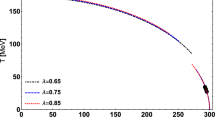Abstract:
We study the O(N) symmetric linear sigma-model at finite temperature as the low-energy effective models of quantum chromodynamics (QCD) using the Cornwall-Jackiw-Tomboulis (CJT) effective action for composite operators. It has so far been claimed that the Nambu-Goldstone theorem is not satisfied at finite temperature in this framework unless the large-N limit in the O(N) symmetry is taken. We show that this is not the case. The pion is always massless below the critical temperature, if one determines the propagator within the form such that the symmetry of the system is conserved, and defines the pion mass as the curvature of the effective potential. We use a regularization for the CJT effective potential in the Hartree approximation, which is analogous to the renormalization of auxiliary fields. A numerical study of the Schwinger-Dyson equation and the gap equation is carried out including the thermal and quantum loops. We point out a problem in the derivation of the sigma meson mass without quantum correction at finite temperature. A problem about the order of the phase transition in this approach is also discussed.
Similar content being viewed by others
Author information
Authors and Affiliations
Additional information
Received: 21 June 2000 / Accepted: 13 September 2000
Rights and permissions
About this article
Cite this article
Nemoto, Y., Naito, K. & Oka, M. Effective potential of the O(N) linear sigma-model at finite temperature. Eur Phys J A 9, 245–259 (2000). https://doi.org/10.1007/s100500070042
Issue Date:
DOI: https://doi.org/10.1007/s100500070042



